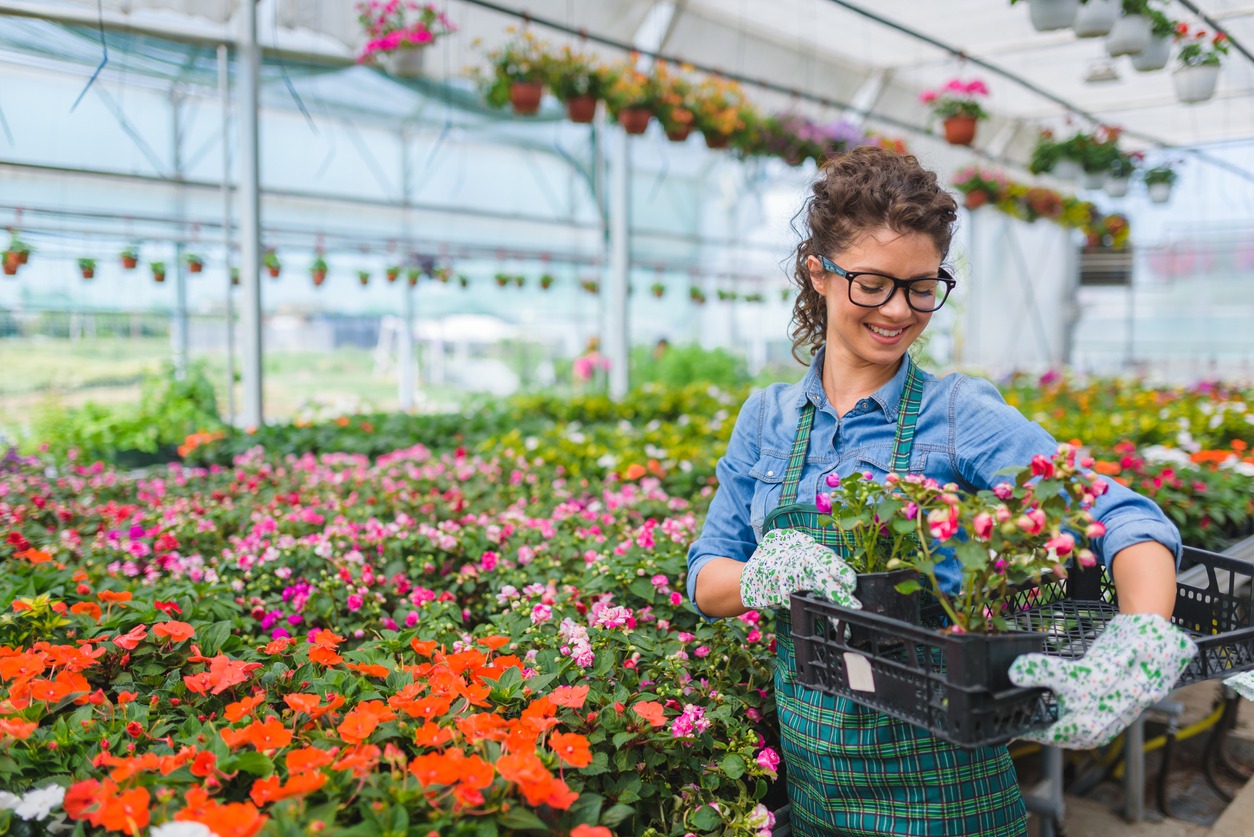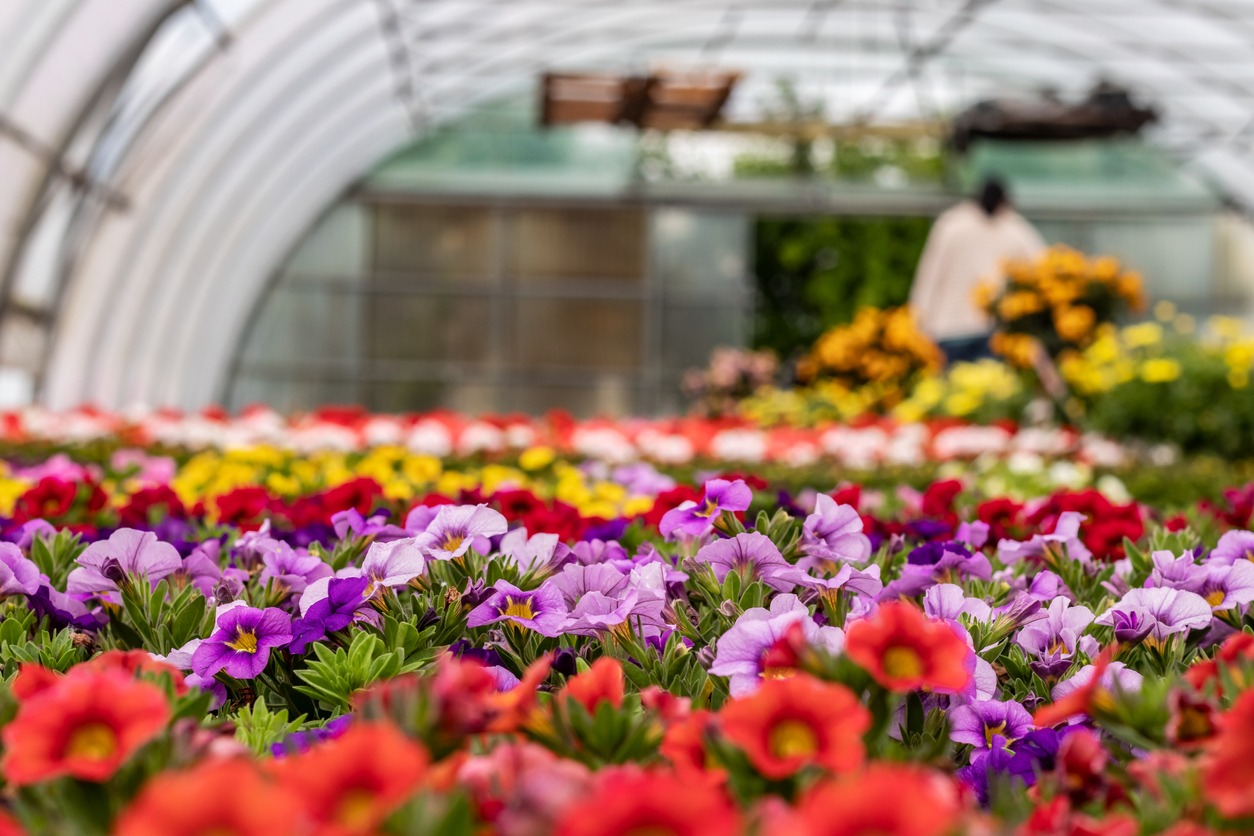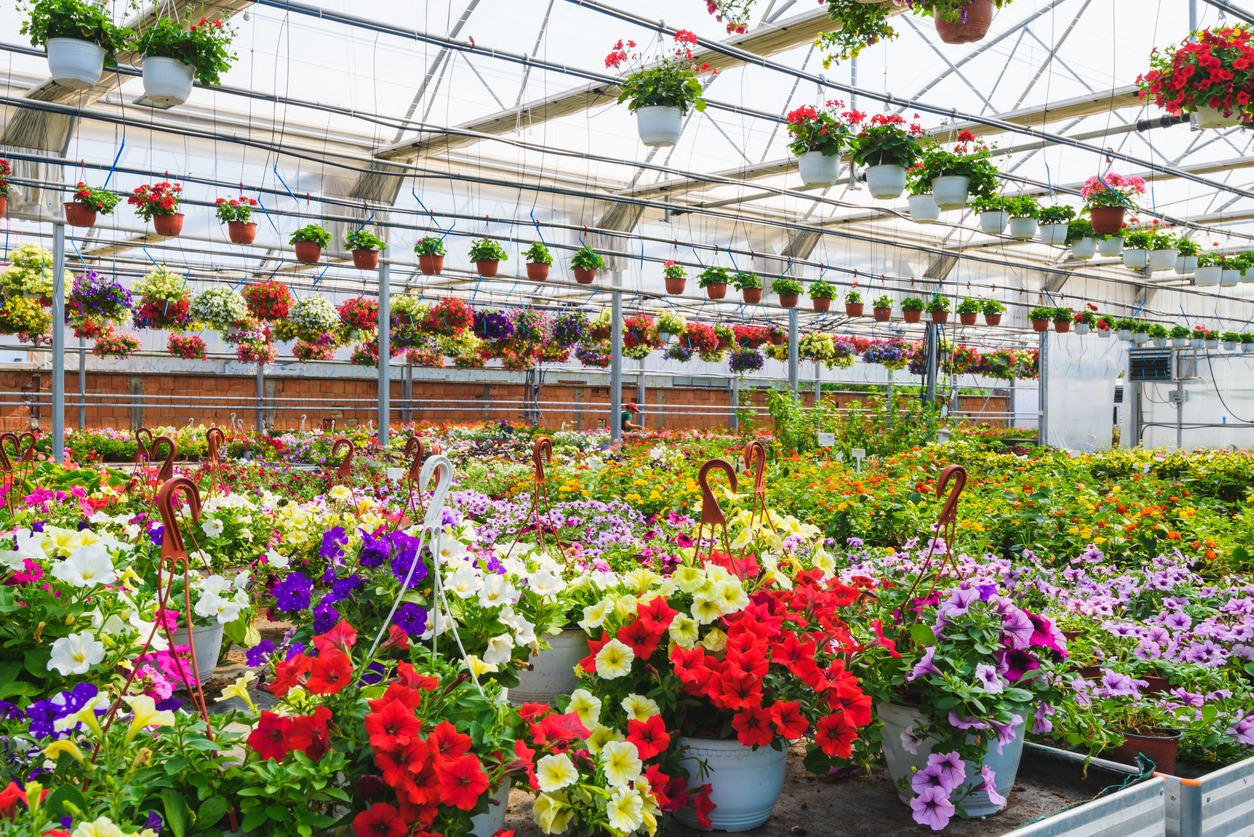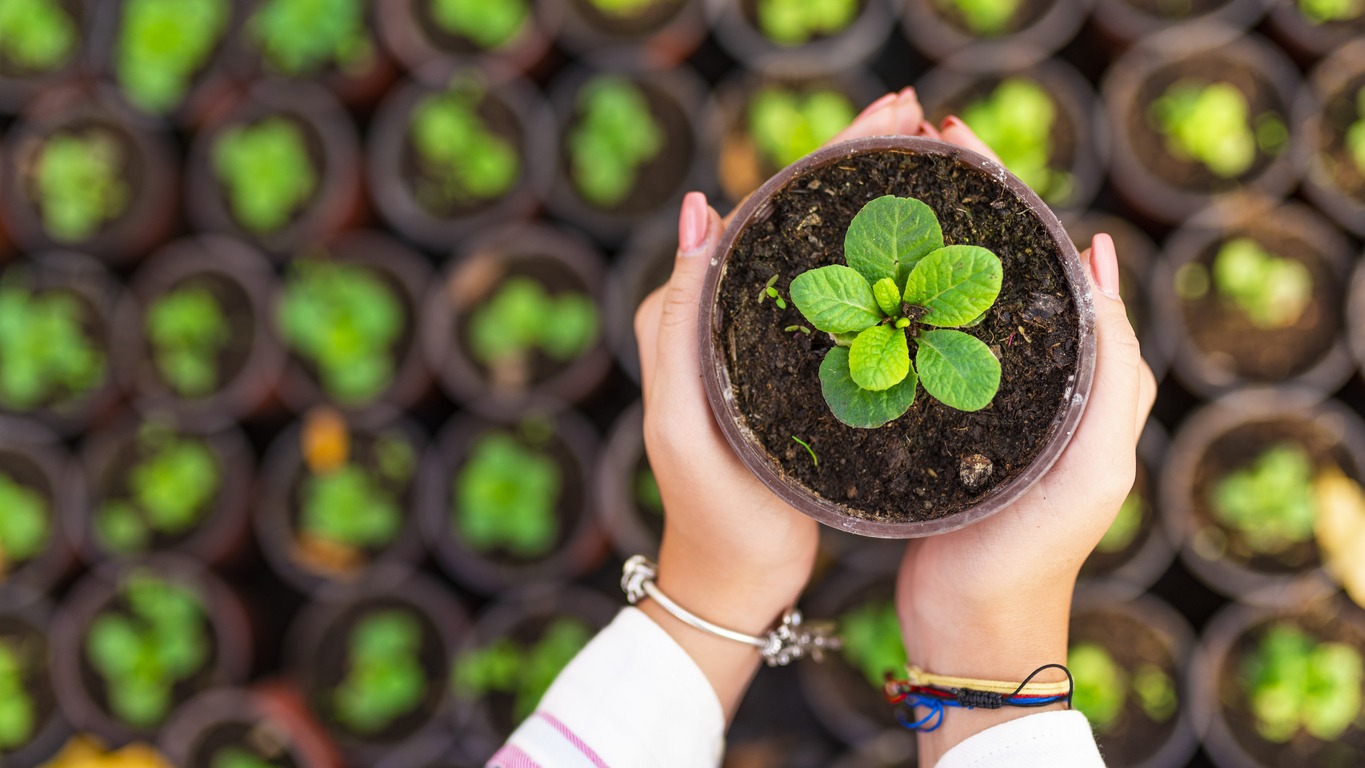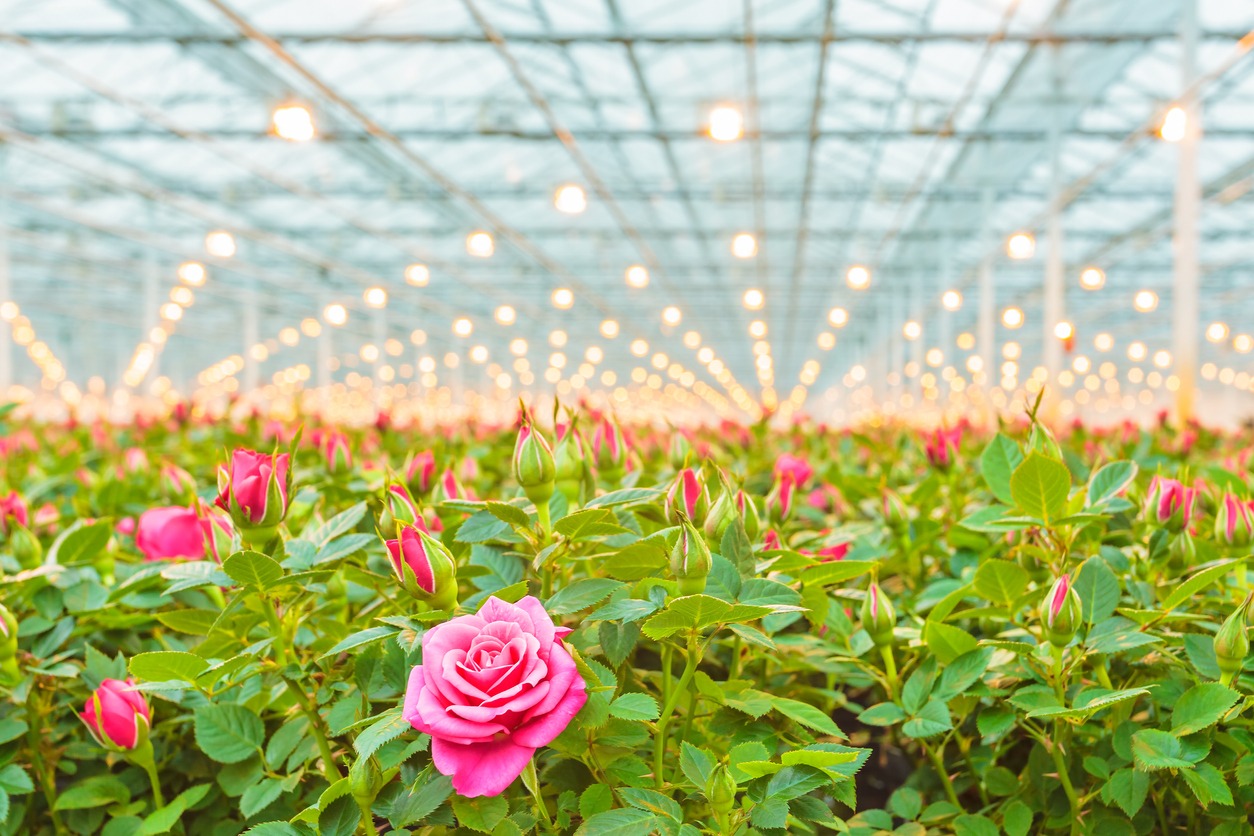Greenhouses offer a sanctuary for plants, shielding them from unpredictable weather and providing an environment where gardeners can fine-tune conditions. Yet, behind the allure of these structures lies a balance of knowledge, care, and dedication. From selecting the right flowers to mastering different gardening techniques, greenhouse gardening requires a blend of science and passion.
How challenging is it to grow flowers in a greenhouse? Are greenhouses truly the magical solution for cultivating flourishing blooms? Learn more about this in this article.
How Does a Greenhouse Work?
Greenhouses work due to solar radiation. Its walls and roof are made of clear materials like glass or plastic. These transparent walls let sunlight in, making the inside of the greenhouse warmer than the outside. This process is sometimes called the “greenhouse effect.” Heating, ventilation, and enriching carbon dioxide are all essential components of a successful greenhouse.
Greenhouses can be of different sizes, from small sheds to huge industrial buildings. Some commercial greenhouses are super high-tech. They have fancy equipment controlled by computers to create the perfect conditions for plant growth.
There are two main types of greenhouses: ones with glass walls and ones with plastic walls. The glass used in greenhouses isn’t as clear as regular window glass. For plastic greenhouses, they use a special type of plastic called PMMA acrylic glass, which is a combination of polyethylene film and polycarbonate sheets.
Why Grow Flowers in a Greenhouse?
Greenhouses allow for better control of the growing environment for plants. Using a greenhouse for growing flowers offers several advantages and benefits.
1. It extends the growing season
Since greenhouses control the environment, flowers can get extended growing seasons beyond what is possible outdoors. This means that flowers can be grown earlier in the spring or later into the fall, providing a longer period for flower production and sales.
2. It allows for climate control
Greenhouses allow growers to control temperature, humidity, and light levels, providing optimal conditions for flower growth. This way, your flowers will be protected from the effects of adverse weather conditions, such as extreme temperatures, frost, or heavy rain.
Growing flowers in a greenhouse also reduce dependence on seasonal variations. This way, you can still grow a consistent and reliable supply of flowers throughout the year, regardless of weather fluctuations or natural growing seasons.
3. It protects your plants from pests and diseases
By creating a physical barrier, greenhouses help protect flowers from pests, insects, and diseases that could otherwise damage or destroy crops. This reduces the need for chemical pest control and allows for more environmentally friendly methods.
4. It enhances crop quality
The controlled environment of a greenhouse enables growers to provide consistent conditions for flower development. Flowers grown in a greenhouse often have fewer blemishes and deformities than those grown outdoors.
5. It increases productivity
With a greenhouse, growers can use vertical growing systems or efficient arrangements to optimize space and maximize crop density. This increases flower yields per square foot compared to traditional field cultivation.
6. It allows a flexible flower selection
Flowers thrive in a suitable climate and soil condition, but if you want to grow a particular flower specie that isn’t compatible with your area, planting them in a greenhouse can allow you to do so. Because it offers environmental control, growers can cultivate exotic or delicate flowers that require specific temperature or humidity levels.
7. It’s ideal for research and experimentation
Greenhouses provide a controlled environment that is ideal for conducting experiments, trials, and research on new flower varieties, cultivation techniques, or sustainable practices. Growers can test different approaches and make informed decisions based on the results obtained within the greenhouse environment.
Challenges of Growing Flowers in a Greenhouse
While greenhouses have a number of benefits, they also come with some challenges. Here are some considerations that may make growing flowers in a greenhouse a little difficult:
1. Greenhouses need more management and maintenance
Putting your plants in a greenhouse does not automatically mean they will thrive. While it can provide climate control, you need to manage it regularly. Temperature, humidity, and light can be controlled to some extent, but maintaining the optimal conditions for flower growth can be a challenge. Different flower species have specific temperature and humidity requirements, and achieving and maintaining the ideal conditions can require careful monitoring and adjustment.
Also, growing flowers in a greenhouse means you have to manage light. Ensuring that flowers receive the right amount and quality of light can be crucial. Supplemental lighting may be necessary during periods of low natural light, such as winter months, to ensure proper growth and flowering.
Watering plants in a greenhouse is also something you must be careful of. Maintaining a consistent and appropriate moisture level is crucial in this environment. Overwatering or underwatering can lead to issues such as root rot or nutrient deficiencies. Installing an efficient irrigation system and monitoring soil moisture levels can help ensure optimal watering.
2. Pests and diseases can still become an issue
Since the greenhouse has walls and a roof, plants can be protected from pests, right? Wrong. While greenhouses provide a protected environment for flowers, they can also create a favorable habitat for pests and diseases due to the high heat and humidity. Due to the enclosed space, pests can thrive if not properly controlled. Regular monitoring, implementing preventive measures, and using appropriate pest control methods are essential to prevent infestations and diseases.
3. Balancing the nutrients in the soil can be a lot of work
Flowers need proper nutrition for healthy growth and flowering. Greenhouse growers need to monitor and maintain the right balance of nutrients in the soil or growing medium. This often involves regular soil testing, adjusting fertilization methods, and providing the necessary nutrients by using the right fertilizers or other organic amendments.
4. Successful flower growing in a greenhouse needs careful planning
To ensure a continuous supply of flowers, timing, and succession planting are essential factors. It requires careful planning and coordination to sow or transplant flowers at appropriate intervals for a consistent harvest throughout the desired period.
While these challenges may make greenhouse flower growing seem difficult, with proper knowledge, experience, and attention to detail, it is certainly possible to successfully cultivate a wide range of flowers in a greenhouse.
How to Grow Flowers in a Greenhouse
Flowers can be grown in a greenhouse in different ways, such as:
1. From Seeds
Depending on the type of flowers you want to grow, you can plant seeds in the greenhouse almost any time of the year. Just check the seed packets for instructions and guides. You can use trays on shelves or big pots or even plant them directly into a special grow bed inside the greenhouse.
Don’t be intimidated though – even the most basic items are perfectly suitable to be used for planting in a greenhouse. You don’t need specialized pots or expensive equipment to do so.
2. From Cuttings
Some flowers can be successfully grown as a result of cuttings. You can take cuttings from the flowers you already have or even get some from friends who know your flower obsession. While it’s tempting to cut from plants you see outside or in other people’s gardens, it’s not acceptable to take flower cuttings without asking for permission first.
If you have a workbench or potting table in your greenhouse, it’s the perfect spot to take those cuttings. Keep them in small containers inside the greenhouse until they start growing, and then you can transfer them to bigger pots as they get stronger. Once they’re all established, you can choose to keep them growing in the greenhouse or move them outside to your garden.
3. By Experimentation
If you’re unsure about which flowers grow best or what conditions they prefer, a greenhouse is the perfect place to carry out controlled experiments to find out what works best for you. The greenhouse provides plenty of space to leave trays of growing seeds and try out different water, light, and soil setups.
The greenhouse is also a fantastic storage spot for the flower seeds you collect at the end of the season. Just keep them in a cool and dry place, like a carefully stored paper bag in the greenhouse. Don’t forget to label the bag so you know exactly what seeds you have when it’s time to plant them again next year.
Essentials of Growing Flowers in a Greenhouse
To start a flower garden in a greenhouse, here are the things you will need (besides soil and plant pots):
1. Starting Seeds
If you want to grow seasonal plants for a longer time, greenhouses are excellent for that purpose. You can plant seeds in hydroponic trays, single-plug trays, or basic seed trays. The level of preparation depends on each plant’s needs. Sometimes, you might need to soak the seeds, stratify them, and then place the trays in the greenhouse. Here are some basics to keep in mind:
- Know your seeds and list the plants you want to grow.
- Containers are essential, but you can recycle and reuse them.
- Get sterile soil to prevent pests and diseases.
- Fertilize your soil to give your plants a boost.
- Water your plants according to their instructions.
- Make sure your climate is suitable for the plants you choose.
- Consider how much sunlight your greenhouse gets daily.
- Keep track of your seeds using labels and dates.
2. Temperature Control System
Depending on where you live, you might need an evaporative cooling system or an electric heater to extend the growing season. Plants need relaxation in warmer months, and the moisture level in the greenhouse is usually high. You can adjust the temperature by using heating or cooling systems. It’s important to choose energy-efficient options to keep your bills low.
3. Light
Light is essential for your plants to grow through photosynthesis. Different plants have different light needs, so pay attention to their requirements. Natural sunlight is great during summer and late spring, but you might need additional lighting for winter or late autumn planting. LED grow lights and fluorescent lamp strips are popular choices. They provide the right spectrum of light and are especially useful in regions with limited sunlight.
4. Watering System
Each plant has specific water requirements, so it’s essential to understand what your plants need. Avoid overwatering or underwatering by learning how to water them correctly. Using a drip system can help control the amount of water each plant receives. Check the water requirements of each plant and observe the soil and plant’s appearance to determine when to water.
5. Accessories
You can make your greenhouse gardening experience easier with accessories like misting systems, fans, tool racks, potting benches, and shelving. Choose accessories based on your budget, the needs of your plants, and the available space in your greenhouse. For example, a drip irrigation system is great for plants that need a slow, steady water supply.
Recommended Flowers to Grow in a Greenhouse
If you’re wondering what flowers are best to consider if you want to grow them in a greenhouse, here’s a helpful list:
- Orchids – Orchids are known for their sensitivity to temperature, which is why they are perfect for greenhouse cultivation. With temperatures ranging from 70-80°F during the day and 50-60°F at night, orchids are quite sensitive. They also prefer humid environments, so they are commonly grown in greenhouses.
- Roses – By setting up a greenhouse, you can provide the ideal temperature range of 60-70°F that roses need. This controlled environment ensures that roses can flourish all year round, especially during the winter when outdoor conditions may not be suitable. While roses in containers are more vulnerable to frost, planting them directly in the ground can help prevent damage from cold weather. With various options available, consider the unique needs of each rose variety when selecting your greenhouse setup.
- Chinese Hibiscus – The vibrant Chinese hibiscus thrives when the soil quality, watering schedule, and temperature are just right. Greenhouses provide the ideal humidity level to keep these flowers moisturized and prevent them from wilting too quickly. To make these stunning flowers flourish, they rely on nutrient-rich soil, consistent watering, and stable temperatures.
- Amazon Lilies – With their tropical nature, Amazon lilies require a warm and humid environment to bloom beautifully. Greenhouses, which can maintain a minimum temperature of 70°F for most of the day, offer an ideal habitat for these lilies. Growing them in containers is recommended for optimal results, and they need at least eight hours of sunlight each day to flourish.
- African Violets – African violets are beautiful and low-maintenance flowers that bloom throughout the long winter months. You can choose from a lovely range of purple, white, and pink African violets. Keeping them in a warm temperature range (between 65°F and 85°F), providing bright, indirect light, and keeping the soil moist is ideal for their growth. It’s important to avoid getting their leaves wet too often to maintain their overall appearance. They can also thrive under artificial lighting during shorter days. Regular fertilization and good drainage are essential, as dry soil or insufficient light can result in fewer or no flowers. Using lukewarm water is recommended to prevent leaf spots.
- Marigolds – Marigolds are wonderful flowers that make great gifts for Mother’s Day due to their vibrant colors and easy care. Marigolds thrive in full sunlight and can withstand hot weather. They can grow well in well-drained, dry, or fertile soil. However, they can be prone to pests. To encourage thicker roots, pinch off the tips of the plants once they have grown and water them at the base. Once established, marigolds require little maintenance, but regular watering is necessary to prevent the soil from drying out.
- Sunflowers – Almost everyone loves sunflowers, and they can grow up to an impressive height of 10 feet! Plant sunflower seeds directly in the soil in a sunny and protected area and watch them grow. They sprout quickly in greenhouses before the growing season begins. Sunflowers require at least 10 to 13 hours of direct sunlight per day, so you can use artificial lighting if natural light is insufficient. Protect the young shoots from slugs and snails by using a covering defense, such as the head of a plastic bottle. You may need to support the stem as the sunflower grows to keep it upright. Tie the stem to a stick using strings to ensure its upward growth.
- Poinsettias – Poinsettias require specific care and have particular needs regarding temperature and watering. While they are often associated with the holiday season, they can be grown year-round in greenhouses as long as they are kept in a semi-cool environment, receive adequate light, and are watered thoroughly.
- Petunias – Petunias come in various varieties and thrive when they receive sufficient sunlight. They also require a specific watering pattern, such as weekly drizzling. They tend to produce their best blooms in seasons with abundant sunshine. Greenhouses provide the right balance of sunlight and temperature to ensure petunias flourish.
- Peace Lily – The peace lily is a popular houseplant known for its attractive foliage and white to off-white flowers. It can make a beautiful decoration in your greenhouse. Creating a tropical environment inside the greenhouse is ideal for peace lilies. With sufficient light, peace lilies will continue to bloom. They are more tolerant of underwatering than overwatering, but overwatering is a common cause of their death. To determine when to water, check the top of the soil and water if it feels dry. Avoid watering if the soil is still moist.

